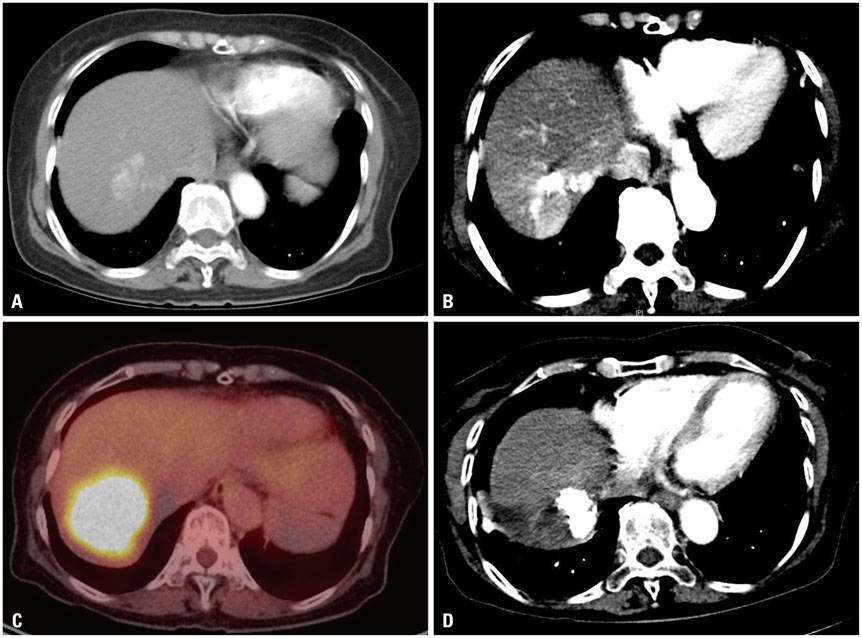Yonsei Med J.
2015 Sep;56(5):1449-1452. 10.3349/ymj.2015.56.5.1449.
High-Dose Vitamin C Promotes Regression of Multiple Pulmonary Metastases Originating from Hepatocellular Carcinoma
- Affiliations
-
- 1Department of Family Medicine, Gangnam Severance Hospital, Yonsei University College of Medicine, Seoul, Korea. hope@yuhs.ac
- 2Yonsei University Graduate School of Medicine, Seoul, Korea.
- 3Department of Internal Medicine, Gangnam Severance Hospital, Yonsei University College of Medicine, Seoul, Korea.
- KMID: 2163643
- DOI: http://doi.org/10.3349/ymj.2015.56.5.1449
Abstract
- We report a case of regression of multiple pulmonary metastases, which originated from hepatocellular carcinoma after treatment with intravenous administration of high-dose vitamin C. A 74-year-old woman presented to the clinic for her cancer-related symptoms such as general weakness and anorexia. After undergoing initial transarterial chemoembolization (TACE), local recurrence with multiple pulmonary metastases was found. She refused further conventional therapy, including sorafenib tosylate (Nexavar). She did receive high doses of vitamin C (70 g), which were administered into a peripheral vein twice a week for 10 months, and multiple pulmonary metastases were observed to have completely regressed. She then underwent subsequent TACE, resulting in remission of her primary hepatocellular carcinoma.
MeSH Terms
-
Aged
Antineoplastic Agents/administration & dosage/*therapeutic use
Ascorbic Acid/*administration & dosage/therapeutic use
Carcinoma, Hepatocellular/*drug therapy/pathology
Chemoembolization, Therapeutic
Combined Modality Therapy
Female
Humans
Liver Neoplasms/pathology/*therapy
Lung Neoplasms/*drug therapy/pathology
Neoplasm Recurrence, Local
Niacinamide/analogs & derivatives/therapeutic use
Phenylurea Compounds/therapeutic use
Treatment Outcome
Antineoplastic Agents
Ascorbic Acid
Niacinamide
Phenylurea Compounds
Figure
Reference
-
1. Padayatty SJ, Katz A, Wang Y, Eck P, Kwon O, Lee JH, et al. Vitamin C as an antioxidant: evaluation of its role in disease prevention. J Am Coll Nutr. 2003; 22:18–35.
Article2. Levine M. New concepts in the biology and biochemistry of ascorbic acid. N Engl J Med. 1986; 314:892–902.3. Bei R, Palumbo C, Masuelli L, Turriziani M, Frajese GV, Volti GL, et al. Impaired expression and function of cancer-related enzymes by anthocyans: an update. Curr Enzym Inhib. 2012; 8:2–21.
Article4. Bram S, Froussard P, Guichard M, Jasmin C, Augery Y, Sinoussi-Barre F, et al. Vitamin C preferential toxicity for malignant melanoma cells. Nature. 1980; 284:629–631.
Article5. Grosso G, Bei R, Mistretta A, Marventano S, Calabrese G, Masuelli L, et al. Effects of vitamin C on health: a review of evidence. Front Biosci (Landmark Ed). 2013; 18:1017–1029.
Article6. Padayatty SJ, Sun AY, Chen Q, Espey MG, Drisko J, Levine M. Vitamin C: intravenous use by complementary and alternative medicine practitioners and adverse effects. PLoS One. 2010; 5:e11414.7. Campbell A, Jack T, Cameron E. Reticulum cell sarcoma: two complete 'spontaneous' regressions, in response to high-dose ascorbic acid therapy. A report on subsequent progress. Oncology. 1991; 48:495–497.
Article8. Padayatty SJ, Riordan HD, Hewitt SM, Katz A, Hoffer LJ, Levine M. Intravenously administered vitamin C as cancer therapy: three cases. CMAJ. 2006; 174:937–942.
Article9. Riordan HD, Hunninghake RB, Riordan NH, Jackson JJ, Meng X, Taylor P, et al. Intravenous ascorbic acid: protocol for its application and use. P R Health Sci J. 2003; 22:287–290.10. Cameron E, Campbell A. The orthomolecular treatment of cancer. II. Clinical trial of high-dose ascorbic acid supplements in advanced human cancer. Chem Biol Interact. 1974; 9:285–315.11. Cameron E, Pauling L. Supplemental ascorbate in the supportive treatment of cancer: reevaluation of prolongation of survival times in terminal human cancer. Proc Natl Acad Sci U S A. 1978; 75:4538–4542.
Article12. Cameron E, Campbell A. Innovation vs. quality control: an 'unpublishable' clinical trial of supplemental ascorbate in incurable cancer. Med Hypotheses. 1991; 36:185–189.
Article13. Moertel CG, Fleming TR, Creagan ET, Rubin J, O'Connell MJ, Ames MM. High-dose vitamin C versus placebo in the treatment of patients with advanced cancer who have had no prior chemotherapy. A randomized double-blind comparison. N Engl J Med. 1985; 312:137–141.
Article14. Padayatty SJ, Sun H, Wang Y, Riordan HD, Hewitt SM, Katz A, et al. Vitamin C pharmacokinetics: implications for oral and intravenous use. Ann Intern Med. 2004; 140:533–537.
Article15. Hoffer LJ, Levine M, Assouline S, Melnychuk D, Padayatty SJ, Rosadiuk K, et al. Phase I clinical trial of i.v. ascorbic acid in advanced malignancy. Ann Oncol. 2008; 19:1969–1974.
Article16. González MJ, Miranda-Massari JR, Mora EM, Guzmán A, Riordan NH, Riordan HD, et al. Orthomolecular oncology review: ascorbic acid and cancer 25 years later. Integr Cancer Ther. 2005; 4:32–44.
Article17. Chen Q, Espey MG, Sun AY, Lee JH, Krishna MC, Shacter E, et al. Ascorbate in pharmacologic concentrations selectively generates ascorbate radical and hydrogen peroxide in extracellular fluid in vivo. Proc Natl Acad Sci U S A. 2007; 104:8749–8754.
Article18. Gonzalez MJ. Lipid peroxidation and tumor growth: an inverse relationship. Med Hypotheses. 1992; 38:106–110.
Article19. Sun Y, Oberley LW, Oberley TD, Elwell JH, Sierra-Rivera E. Lowered antioxidant enzymes in spontaneously transformed embryonic mouse liver cells in culture. Carcinogenesis. 1993; 14:1457–1463.
Article20. Cho D, Hahm E, Kang JS, Kim YI, Yang Y, Park JH, et al. Vitamin C downregulates interleukin-18 production by increasing reactive oxygen intermediate and mitogen-activated protein kinase signalling in B16F10 murine melanoma cells. Melanoma Res. 2003; 13:549–554.
Article21. Chen C, Sun J, Liu G, Chen J. Effect of small interference RNA targeting HIF-1alpha mediated by rAAV combined L: -ascorbate on pancreatic tumors in athymic mice. Pathol Oncol Res. 2009; 15:109–114.
Article22. Mikirova N, Casciari J, Riordan N, Hunninghake R. Clinical experience with intravenous administration of ascorbic acid: achievable levels in blood for different states of inflammation and disease in cancer patients. J Transl Med. 2013; 11:191.
Article
- Full Text Links
- Actions
-
Cited
- CITED
-
- Close
- Share
- Similar articles
-
- Multiple Bone Metastases in a Patient with Small Hepatocellular Carcinoma
- Two Cases of Cutaneous Metastasis Originating from Hepatocellular Carcinoma
- Tetraspan(in)-mediated immune regulation in hepatocellular carcinoma: Editorial on “Targeting TM4SF1 promotes tumor senescence enhancing CD8+ T cell cytotoxic function in hepatocellular carcinoma”
- Pulmonary metastasis of primary hepatocellular carcinoma
- TM4SF1 - A new immune target for treatment of hepatocellular carcinoma: Editorial on “Targeting TM4SF1 promotes tumor senescence enhancing CD8+ T cell cytotoxic function in hepatocellular carcinoma”



